The Scotch Broom Guide
Scotch Broom (Cytisus spp.) is a deciduous, sun-loving shrub known for its wispy stems, arching growth habit, and prolific spring to early summer bloom. Often covered in masses of vibrant yellow, red, or bi-colored flowers, it adds texture and bold seasonal color to lean or poor soils. Its broomstick-like branches and drought tolerance make it a distinctive presence in landscapes that favor minimal upkeep and naturalized design.
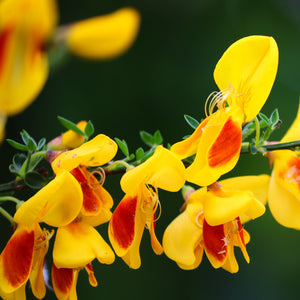
About
Native to western and central Europe, Scotch Broom was introduced to North America as an ornamental plant and for erosion control. It belongs to the pea family (Fabaceae), producing pea-like flowers and long, slender seed pods. Its fast growth and ability to thrive in poor soils make it appealing for slopes and difficult spots, though some species have become invasive in parts of the Pacific Northwest and California.
Cytisus scoparius is the most well-known species, with fine green stems and very few leaves, often mistaken for evergreen in mild climates. The plant spreads by seed, which can be prolific, especially in disturbed or unmanaged areas. Still, with mindful placement and occasional pruning, cultivated varieties can be attractive, controlled, and highly functional in home gardens.
Garden cultivars like 'Lena' feature warm orange-red flowers, while 'Moonlight' and the "Sister" series bring soft yellows and golds to spring color palettes. These cultivars are typically compact and more restrained in habit than the wild types.
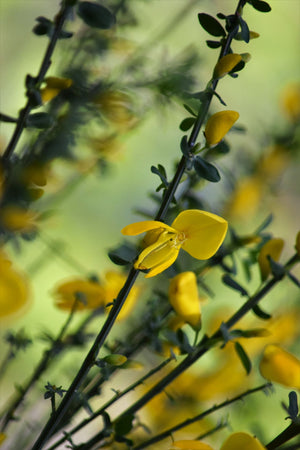
PLANTING
USDA Hardiness Zones: Typically hardy in Zones 5–8, though winter protection may be needed in colder regions.
Soil: Prefers sandy, well-drained soils with low fertility. Avoid heavy clay or consistently wet soils.
Sunlight: Requires full sun (6+ hours daily) for best flowering and form.
Watering: Once established, Scotch Broom is very drought-tolerant and requires little supplemental water.
Spacing: Space 3 to 5 feet apart depending on cultivar and desired density.
Planting Time: Spring or early fall, allowing time for root establishment before extreme heat or cold.
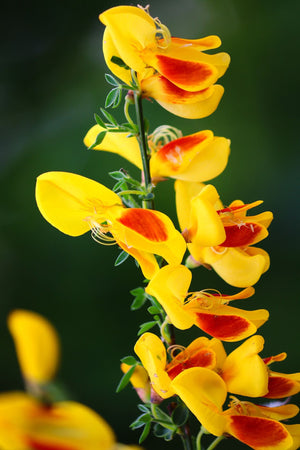
CARE
Watering: Water regularly during the first growing season to establish roots. Once mature, only occasional watering is needed during prolonged dry spells.
Fertilizing: Avoid high-fertility soils or heavy fertilizing, which can reduce flowering and lead to floppy growth. Scotch Broom thrives in lean conditions.
Pruning: Prune immediately after flowering to shape and control size. Cut back up to one-third of the plant, avoiding cutting into old, woody stems as they may not resprout.
Pests and Diseases: Generally pest-free and disease-resistant. May develop root rot in poorly drained soils.
Mulching: Use a light mulch in the first season to suppress weeds and retain moisture, but avoid piling against stems.
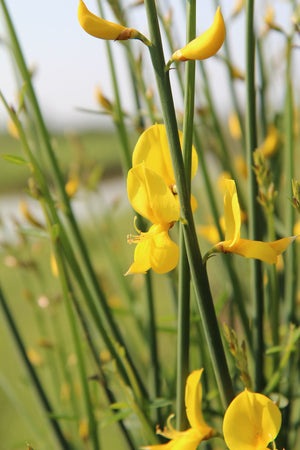
HOW TO USE
Focal Point Planting: In xeriscapes or gravel gardens, Scotch Broom provides bold spring interest. Its vibrant blooms and upright form can anchor dry borders or serve as a dramatic seasonal focal point.
Mass Plantings for Erosion Control: Ideal for stabilizing slopes, banks, or sandy areas. Its deep roots and rapid spread help prevent soil loss, especially in areas with limited irrigation.
Pollinator Support: The pea-like flowers attract bees and beneficial insects during their bloom period, typically late spring through early summer.
Mixed Shrub Borders: Pair with other drought-tolerant, sun-loving shrubs like Potentilla, Caryopteris, or Lavender. Ornamental grasses such as Nassella tenuissima or Panicum 'Shenandoah' provide a soft contrast.
Coastal and Salt-Tolerant Landscapes: Scotch Broom handles salty winds and sandy soils well, making it suitable for coastal installations with good drainage.
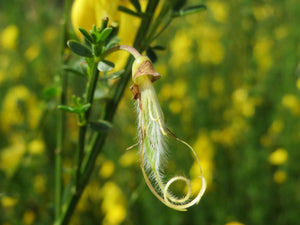
Common Questions
How to prune Scotch Broom? Prune just after flowering, cutting back the newest growth to shape and control size. Avoid cutting into old, woody stems, as these may not regenerate.
Do deer eat Scotch Broom? Deer generally avoid Scotch Broom due to its bitter taste and low palatability.
Do rabbits eat Scotch Broom? Rabbits tend to steer clear of Scotch Broom as well, though young plants may be occasionally nibbled.
Is Scotch Broom toxic to dogs? Yes, all parts of the plant are considered toxic if ingested by dogs, potentially causing vomiting, lethargy, or more severe symptoms.
Is Scotch Broom toxic to cats? Yes, Scotch Broom is also toxic to cats if ingested, with similar gastrointestinal symptoms.
Is Scotch Broom invasive? Yes, in certain areas—particularly the Pacific Northwest—it has naturalized aggressively and is considered invasive. Use cultivated forms responsibly and deadhead to prevent unwanted spread.
When does Scotch Broom bloom? Most Scotch Broom cultivars bloom in late spring to early summer, typically between May and June, depending on climate.
Conclusion
Scotch Broom brings vibrant seasonal color, drought resistance, and structural interest to sunny, low-maintenance landscapes. While best suited for controlled garden settings due to its spreading potential, the cultivated varieties offer impressive ornamental value when used thoughtfully. Whether you're stabilizing a slope or designing a water-wise border, Scotch Broom can be a standout element with lasting appeal.
The Scotch Broom Collection
Sold Out
Sold Out
Sold Out
Sold Out
Sold Out
